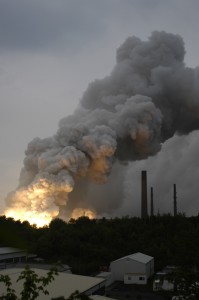 Stories like these are, unfortunately, the reason the US has strict safety standards in place. Last week a swift-moving fire trapped workers inside a poultry slaughterhouse in northeastern China. The factory had only a single open emergency exit and killed at least 119 people in the scurry to find an open door.
Stories like these are, unfortunately, the reason the US has strict safety standards in place. Last week a swift-moving fire trapped workers inside a poultry slaughterhouse in northeastern China. The factory had only a single open emergency exit and killed at least 119 people in the scurry to find an open door.
This accident, like so many others, highlights the high human costs of China’s lax industrial safety standards, which continue to endanger workers despite recent improvements in the country’s work safety record. It comes shortly after the tragic factory collapse in Bangladesh, which we discussed in this post, where more than 1,100 people died.
In addition to the 119 people who lost their lives, dozens of people were injured in the blaze. Here in the US, we’re lucky to have standards like the International Building Code in place to keep us, and our family members out of harm’s way when disaster strikes.
To read a more detailed article covering this tragedy; check out The New York Times
Google

The accident highlights the high human costs of China’s lax industrial safety standards, which continue to endanger workers despite recent improvements in the country’s work safety record. It also comes amid growing international concern over factory safety across Asia following the collapse in April of a garment factory building in Bangladesh where more than 1,100 people died.
This page addresses the hazards in the poultry processing industry. This industry can be divided into two stages each with its own particular hazards. The first stage is the raising of live birds to the desired weight, delivery to the processing plant and preparing the live birds for slaughtering. The second stage is the slaughtering, processing, and packaging of the birds. Major hazards in the first stage are generally respiratory hazards resulting from exposure to organic dusts (litter, manure, dander) and ammonia. These are controlled using ventilation and personal protective equipment (PPE). Additional hazards include those associated with agricultural machinery, feed delivery systems, waste removal systems, and ergonomic hazards especially as birds are prepared for slaughtering. A potentially significant hazard is the presence of microbiologicals and endotoxins in the organic dusts. In the second stage, common elements in an effective safety and health program include control of ergonomic hazards to prevent cumulative trauma disorders, machine guarding and PPE to prevent cuts, care of walking/working surfaces to reduce trips and falls, design and maintenance of electrical systems, and lockout/tagout procedures to prevent accidental startup of machinery. There are currently no specific OSHA standards for poultry processing.
The way food safety has dominated this debate highlights how, in a country obsessed with food, we still fail to appreciate the people whose work brings the food to our table. While the government has responded to public demands for better inspection processes, tens of thousands of poultry workers may soon find their already dangerous job becoming much more so, with almost no public debate. We consider a food product safe if it’s something we can feed our children. But what if producing the food does so much damage to the hands of workers that they are unable to hold their own?
The oil and gas industry, nuclear plants and the machinery sector, to name but a few, all rely heavily on functional safety to achieve safety for the equipment giving rise to the hazards.